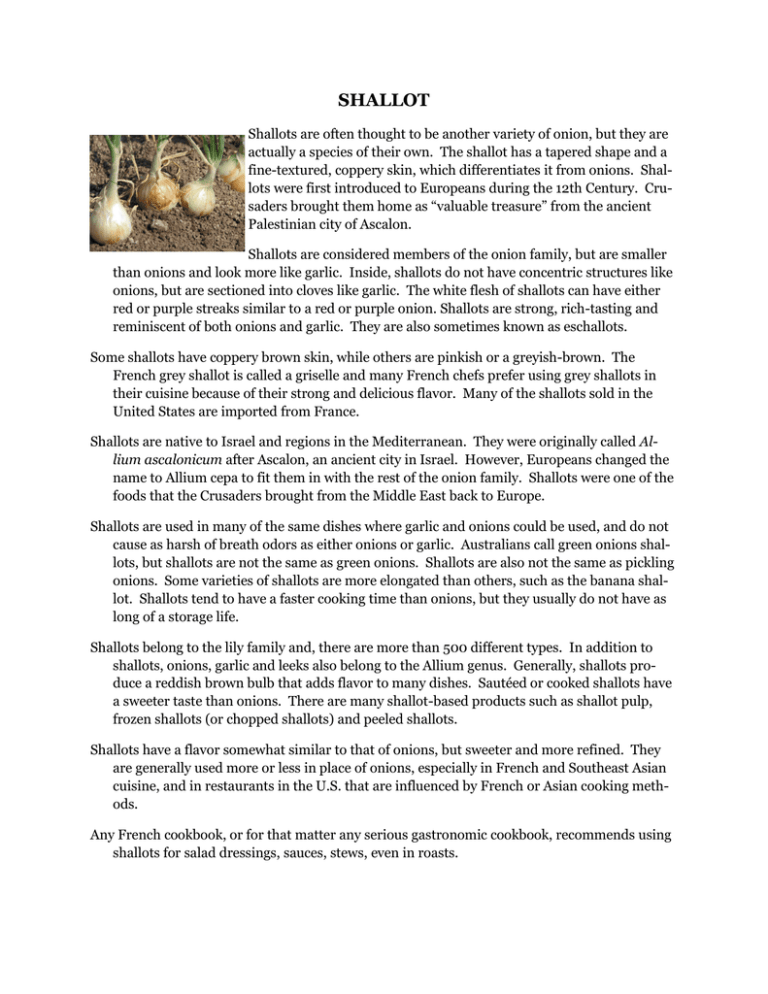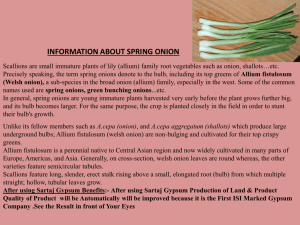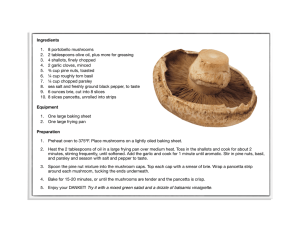SHALLOT
advertisement

SHALLOT Shallots are often thought to be another variety of onion, but they are actually a species of their own. The shallot has a tapered shape and a fine-textured, coppery skin, which differentiates it from onions. Shallots were first introduced to Europeans during the 12th Century. Crusaders brought them home as “valuable treasure” from the ancient Palestinian city of Ascalon. Shallots are considered members of the onion family, but are smaller than onions and look more like garlic. Inside, shallots do not have concentric structures like onions, but are sectioned into cloves like garlic. The white flesh of shallots can have either red or purple streaks similar to a red or purple onion. Shallots are strong, rich-tasting and reminiscent of both onions and garlic. They are also sometimes known as eschallots. Some shallots have coppery brown skin, while others are pinkish or a greyish-brown. The French grey shallot is called a griselle and many French chefs prefer using grey shallots in their cuisine because of their strong and delicious flavor. Many of the shallots sold in the United States are imported from France. Shallots are native to Israel and regions in the Mediterranean. They were originally called Allium ascalonicum after Ascalon, an ancient city in Israel. However, Europeans changed the name to Allium cepa to fit them in with the rest of the onion family. Shallots were one of the foods that the Crusaders brought from the Middle East back to Europe. Shallots are used in many of the same dishes where garlic and onions could be used, and do not cause as harsh of breath odors as either onions or garlic. Australians call green onions shallots, but shallots are not the same as green onions. Shallots are also not the same as pickling onions. Some varieties of shallots are more elongated than others, such as the banana shallot. Shallots tend to have a faster cooking time than onions, but they usually do not have as long of a storage life. Shallots belong to the lily family and, there are more than 500 different types. In addition to shallots, onions, garlic and leeks also belong to the Allium genus. Generally, shallots produce a reddish brown bulb that adds flavor to many dishes. Sautéed or cooked shallots have a sweeter taste than onions. There are many shallot-based products such as shallot pulp, frozen shallots (or chopped shallots) and peeled shallots. Shallots have a flavor somewhat similar to that of onions, but sweeter and more refined. They are generally used more or less in place of onions, especially in French and Southeast Asian cuisine, and in restaurants in the U.S. that are influenced by French or Asian cooking methods. Any French cookbook, or for that matter any serious gastronomic cookbook, recommends using shallots for salad dressings, sauces, stews, even in roasts. The term shallot is used to describe two different Allium species of plant. The French grey challot or griselle, which has been considered to be the “true shallot” by many, is a species that grows wild from Central to Southwest Asia. The botanical name of shallot is Allium ascalonicum and it belongs to the family Liliaceae. Shallots probably originated in Asia, traveling from there to India and the eastern Mediterranean. The name “shallot” comes from Ashkelon, a city in Israel, where people in classical Greek times believed shallots originated. The outer skin of shallots can vary from golden brown to gray to rose red, and their off-white flesh is usually tinged with green or magenta. Shallots are much favored by chefs because of their firm texture and sweet, aromatic, yet pungent, flavor. Raw shallots have a strong pungency, stronger than most onions. Their true character comes when lightly sautéed in butter until they are translucent in color or when used in gravies and creamy sauces. It is very difficult to evaluate shallot quality in the raw form. Many people confuse shallots with green onions, scallions and leeks. The young green onion has a definite bulb formation with the same concentric arrangement that the dry onion has. Scallions are any shoots from the white onion varieties that are pulled before the bulb has formed. Leeks are similar in appearance to scallions but have flat leaves and the white stalk is thicker and longer. Generally, shallot bulbs are the size of chestnuts, sometimes larger, pear-shaped, narrowed in the upper part into a rather long point, and covered with a russet colored skin of a coppery red color in the lower part shading off into grey towards the upper extremity. Kurt Nolte is an area agriculture agent with the Yuma County Cooperative Extension. He can be reached at 928-726-3904.







